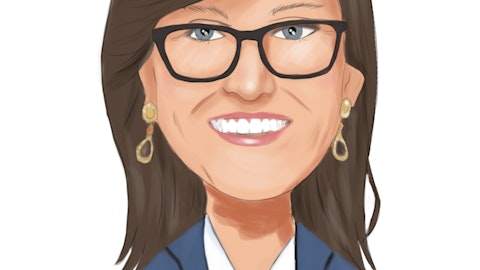Onaiza Cadoret: Sure. Thanks Richard. Yes, I see the market research on this has been really consistent. We have been looking at this market for a while ever since we started the safety Phase 3s. And I think as your – the patients are really looking for that efficacy and tolerability and convenience in a single drug. And they just don’t have that right now. And that is the biggest unmet need. And we do believe that the donidalorsen data will actually provide that with our positive top line results from the OASIS study hitting on a multitude of different efficacy parameters, safety, tolerability and self-administered dual volume injection either every four weeks or eight weeks, we can actually really change the treatment paradigm here.
And then complementary to that will be the Switch data that you already asked about and Richard addressed as well as the OLE data, which will continue to show the durability of the drug. So, very excited and look forward to sharing the data later on in the medical meeting.
Brett Monia: And when we present our plan to present data, Joey, later this year will include the – not only the Phase 3 data, but also the Phase 2 open label extension data as well as a really, really good robust presentation on the Switch study, everything that we are seeing there. So, stay tuned.
Joseph Stringer: Great. Thanks so much for taking our questions.
Operator: Our next question comes from Kostas Biliouris with BMO Capital Markets. Please go ahead.
Kostas Biliouris: Thanks for taking our question. A two-part question from us on CARDIO-TTRransform. Can you remind us how long is the minimum follow-up for its patient in this study and what will be the maximum follow-up that you will have there in some patients. And the second part, how important do you think is the number of events that occurred between 30 months and 36 months in this population? Thank you.
Brett Monia: So, this is a highly competitive space, Kostas. We are not sharing follow-up data, what we expect when we re-up the study, of course, we don’t know we are going to be reading out the study early or later anyway. But we are not sharing expectations for what percentage of patients would be on treatment for what length of time at this point. We would look forward to doing that when the study reads out. As far as number of events over a few months, I mean, Eugene, it’s pretty negligible, isn’t it?
Eugene Schneider: Yes. I would think so in comparison the proportion of the total time of observation. It’s difficult to say exactly what that is, but your question was related to just a couple of months. So, I am not sure we have really good answer. But as Brett said, it’s probably very minimal.
Brett Monia: Yes. We think we have the right trial design, trial duration and the size of the study, Kostas, we don’t think a few months is really going to matter that much. And we are very pleased that we made the decision we made a couple of years ago to upsize our study.
Kostas Biliouris: Very helpful. Thank you.
Operator: Our next question comes from Yaron Werber with Cowen. Please go ahead.
Yaron Werber: Great. I got a couple of questions. When you guys expanded essentially doubled the study of CARDIO-TTRransform, if I remember correctly, I think one of the reasons was to also go and enroll in areas with tafamidis wasn’t necessarily available. Just remind us if that’s correct? And is that so, do you have a sense, are you able to enroll New York Heart I and II, a lot of those patients? And any sense what the overall tafamidis drop is going to be? And then just quickly on OASIS, can you give us any color on how the Phase 3 stacks relative to the Phase 2 on efficacy is? Thank you.
Brett Monia: Thanks Yaron. So, you remember correctly, the sites that we opened up initially in the CARDIO-TTRransform study were largely U.S. sites, right, guys. And as you know, in the U.S., there is a lot of tafamidis usage. So, we actually slowed down, stopped enrollment at one point, a couple of years ago in the U.S., except for sites that had the hereditary patients that they were able to continue to bring in because we got a good percentage of those patients in the study, too. And we emphasize, we prioritize sites outside the U.S. or anywhere really, if we could find sites in the U.S., too, where tafamidis wasn’t available and that worked. We have a good balance between patients that are naïve to stabilizer as well as on tafamidis. We are also pleased with NYHA Class the proportion we have in Classes 1, 2 and 3 and Eugene should you [indiscernible] with that.
Eugene Schneider: Yes. We are not going to do comparisons, Jerome, on Phase 3 and Phase 2 data. We are going to look forward to sharing that data at a conference, as I mentioned earlier, around mid-year, this year. So, stay tuned to that. And then maybe we have time for one more question.
Operator: Our final question comes from Allison Bratzel with Piper Sandler. Please go ahead.
Allison Bratzel: Hey. Thanks for fitting me in and taking our question. So, just another one on donidalorsen, just on that switching study, can you remind us of the washout or weaning protocol prior to patients starting on donidalorsen. And just how well does that represent a feasible real-world switching strategy for patients currently on injectable or oral prophylaxis? And then just separately, from your conversations with the field, how does Q8-week versus monthly dosing change patients and physicians view of the drug’s convenience profile? Thank you.
Brett Monia: Yes. Maybe I will ask Onaiza to take that second one on Q4, Q8-week dosing. But Eugene, I mean I don’t think of this as a washout, right. These patients are not being washed out. They would be at risk through attacks if they were being washed out. It’s really just knowing what the half-life of the drug is, how long it lasts, and we bring them off of our prophylactic treatment, and we wean them on donidalorsen, which has a fast set of action to begin with, and that thereby, we can wean them off without putting them into harm’s way, if you will. So, it’s not really a wash out, it’s a – that will be different for each platform.
Eugene Schneider: Different for different prophylaxis. Half life is different for oral versus injectables. So, we will publish all of that data in detail. The point of that study was really to provide some specifics around how these patients could be transitioned to different…
Brett Monia: These that really, we haven’t had any gaps in protection, I mean these patients are getting on very well as we transition them on to donidalorsen. So, very much looking forward to that our presentation. Onaiza, what do you think about every four weeks and every eight-week dosing from a competitive or a patient preference standpoint?
Onaiza Cadoret: Yes. Allison, I think here, the physicians are saying, listen, we want – if we are to kind of, for a prophylactic to really prevent the breakthrough attacks is for the patient to be compliant. And they see a lot of switching off currently with the current therapies where they are migrating to a less frequent dose, but then they start having attacks and they go back to have more frequent dose and they go back to a less frequent dose. So, they see that cycle and what they really want is the compliance and with the efficacy as well. So, we really do think that this gives them another treatment paradigm shift where you can start on a four-week and potentially have patients who are stable and not having any attacks go through the eight-week and keep them there for a long period of time. So, the compliance drives the efficacy of the product.
Brett Monia: Okay. Well, thanks Allison. Thanks Onaiza. Thanks everybody for participating, for joining us on our call today. We really are excited about the great progress we have already made this year and everything ahead of us. It’s really shaping up to be a really remarkable exciting 2024. And we are looking forward to sharing updates along the way. Until then, have a great day, everybody. Thanks.
Operator: Goodbye.





